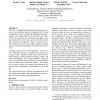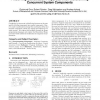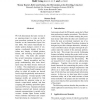11324 search results - page 36 / 2265 » Coordination Models and Languages |
HICSS
2007
IEEE
13 years 9 months ago
2007
IEEE
We describe the evolution of a statistical survey design visual language from a standalone design-time modelling language into an environment supporting design, coordination, exec...
ICSE
2000
IEEE-ACM
13 years 11 months ago
2000
IEEE-ACM
Little-JIL, a language for programming coordination in processes is an executable, high-level language with a formal (yet graphical) syntax and rigorously defined operational seTh...
SAC
2008
ACM
13 years 7 months ago
2008
ACM
Complexity in concurrent or distributed systems can be managed by dividing component into smaller components. However, such transformations change the coordination behaviour betwe...
ACL
2003
13 years 9 months ago
2003
We will demonstrate the latest version of an ongoing project to create an intelligent procedure assistant for use by astronauts on the International Space Station (ISS). The syste...
BMCBI
2004
13 years 7 months ago
2004
Background: Hidden Markov Models (HMMs) have proven very useful in computational biology for such applications as sequence pattern matching, gene-finding, and structure prediction...



